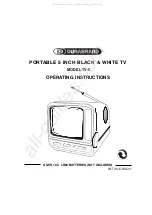
152
The characteristics (4), (5) and (6) shown here apply when using a rod electrode whose
characteristic corresponds - at a given arc length - to the load line (1).
Depending on what welding current (I) has been set, the point of intersection (operating
point) of characteristics (4), (5) and (6) will be displaced along the load line (1). The oper-
ating point provides information on the actual welding voltage and the actual welding cur-
rent.
Where the welding current (I
1
) is permanently set, the operating point may migrate along
the characteristics (4), (5) and (6) depending on the welding voltage at that moment in time.
The welding voltage U is dependent upon the length of the arc.
If the arc length changes (e.g. in accordance with the load line (2)) the resulting operating
point will be the point where the corresponding characteristic (4), (5) or (6) intersects with
the load line (2).
Applies to characteristics (5) and (6): Depending upon the welding voltage (arc length), the
welding current (I) will also become either smaller or larger, even though the value set for
I
1
remains the same.
(1)
Load line for rod electrode
(2)
Load line for rod electrode where arc length is in-
creased
(3)
Load line for rod electrode where arc length is re-
duced
(4)
Characteristic where "CON" parameter is select-
ed (constant welding current)
(5)
Characteristic where "0.1 - 20" parameter is se-
lected (drooping characteristic with adjustable
slope)
(6)
Characteristic where "P" parameter is selected
(constant welding power)
(7)
Example of pre-set arc-force dynamic where
characteristic (5) or (6) is selected
(8)
Possible change in the current where character-
istic (5) or (6) is selected, as a function of the
welding voltage (arc length)
(a)
Operating point where arc length is long
(b)
Operating point when welding current IH is set
(c)
Operating point where arc length is short
Setting example: I1 = 250 A, arc-force dynamic = 50
Polarity
Unit
-
Setting range
AC (only MagicWave) / DC- / DC+
10
20
30
40
50
60
U (V)
0
0
4
0
0
3
0
0
1
200
I (A)
I
1
+ Dynamik
I
1
- 50 %
(8)
(2)
(1)
(3)
(7)
(c)
(c)
(b)
(a)
(a)
(6)
(5)
(4)
Summary of Contents for MagicWave 2200 Comfort
Page 2: ...2...
Page 4: ...4...
Page 10: ...10...
Page 23: ...General information...
Page 24: ......
Page 27: ...Control elements and connections...
Page 28: ......
Page 39: ...Installation and commissioning...
Page 40: ......
Page 45: ...Welding...
Page 46: ......
Page 89: ...Setup settings...
Page 90: ......
Page 170: ...170...
Page 171: ...Troubleshooting and maintenance...
Page 172: ......
Page 183: ...183 EN Disposal Dispose of in accordance with the applicable national and local regulations...
Page 184: ...184...
Page 185: ...Appendix...
Page 186: ......
Page 195: ...Spare parts and circuit diagrams...
Page 196: ...196 Spare parts list TransTig MagicWave 2200 Comfort...
Page 197: ...197...
Page 198: ...198 Spare parts list TransTig MagicWave 2500 3000...
Page 200: ...200 Spare parts list TransTig 4000...
Page 201: ...201...
Page 202: ...202 Spare parts list MagicWave 4000...
Page 203: ...203...
Page 204: ...204...
Page 205: ...205 Circuit diagrams MagicWave 2200 Comfort V 12 06 2014...
Page 206: ...206 Circuit diagrams MagicWave 2500 Comfort...
Page 207: ...207 Circuit diagrams MagicWave 3000 Comfort...
Page 208: ...208 Circuit diagrams MagicWave 4000 Comfort V 17 12 2012 1 2...
Page 209: ...209 V 17 12 2012 2 2...
Page 210: ...210 Circuit diagrams TransTig 2200 Comfort V 14 12 2010...
Page 211: ...211 Circuit diagrams TransTig 2500 Comfort...
Page 212: ...212 Circuit diagrams TransTig 3000 Comfort...
Page 213: ...213 Circuit diagrams TransTig 4000 Comfort V 17 12 2012...
Page 214: ......
Page 215: ......
















































